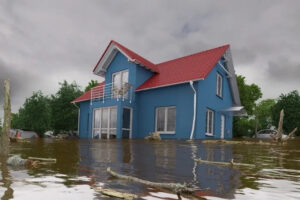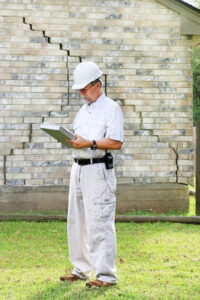Can Your House Be Raised? Here’s What You Need to Know
Hey there! If you’re reading this, you’ve either dealt with flooding issues or worried about your home’s foundation. Maybe both? I get it, these problems keep you up at night. After helping countless homeowners lift their houses over the years at Du-West, I’ve learned exactly what makes a home a good candidate for raising. Let me break down the factors that determine if your house can join the “high and dry” club!
House Raising All Starts With Your Foundation (The Most Important Part!)
Your foundation is basically the deciding factor here.
Think of it like this:
- Pier and Beam Homes: These are the easiest to work with! If your home already sits on piers, you’re in luck. It’s like your house was designed with future lifting in mind. We just need to get underneath, add support, and up she goes!
- Slab Foundations: A bit trickier, but totally doable. We need to lift the entire concrete slab along with your house. Itrequires more equipment and planning, but we’ve got this down to a science after years of practice.
- Basement Foundations: The most complex scenario. We have to consider if those basement walls can handle the pressure of a lift. Sometimes we need to add reinforcement first, but many basement homes can still be successfully raised.
Not sure what type of foundation you have? No worries! That’s why we do a thorough inspection first.
How Healthy Is Your Home’s Structure?
I always tell homeowners that a house is like a body it needs to be in decent shape before undergoing a major procedure.
Before we lift anything, we check for:
- Cracks in walls or ceilings (especially the zigzaggy ones)
- Floors that aren’t level or feel bouncy when you walk
- Any signs of rotting wood in the frame
- Doors that stick or windows that won’t close properly
Don’t panic if you’ve noticed some of these issues! They don’t automatically disqualify your home. We might just need to address them before the main event.
The Ground Beneath Your Feet Matters Too
You wouldn’t build a sandcastle on wet sand, right? Same principle applies to raising a house. The soil under your home plays a huge role. Sandy or rocky soil is pretty stable and usually makes for a straightforward job. But if you’re in an area with clay soil (hello, fellow Texans!), we might need to take extra steps. Clay expands when wet and shrinks when dry, not ideal for keeping things level. We sometimes recommend soil testing to make sure we’re planning properly. Better safe than sorry!
House Raising Red Tape Alert: Permits and Building Codes
I won’t sugarcoat it, there’s paperwork involved. Each city has its own rules about house raising, and flood-prone areas have FEMA requirements that dictate minimum elevation heights.
The good news? We handle all that boring stuff for you! Permits, inspections, engineering approvals – consider it done. We’ve navigated this process countless times and know exactly what local officials are looking for.
What About All Those Utility Connections?
Great question!
Everything needs to be disconnected before we lift:
- Water and sewer lines
- Electrical connections
- Gas lines
- HVAC systems
After the lift, we extend and reconnect everything to your newly elevated home. It sounds complicated (and it is), but for our experienced team, it’s just another day at the office.
Your Yard Situation
Believe it or not, we need to consider your property’s layout too.
To position our equipment safely, we need:
- Enough space to work around your home
- A plan for dealing with trees, power lines, or other obstacles
- A strategy for temporary removal of attached structures like decks or porches
Don’t worry if your lot is tight we have specialized equipment for almost any situation. We’ll figure it out!
When Should You Call Us?
Don’t wait until you’re knee-deep in floodwater!
Here’s when to pick up the phone:
- After your first flood (don’t wait for the second!)
- When your insurance premiums are climbing because of flood risk
- If you’re already planning foundation repairs
- When you’re thinking about adding a second story
The sooner we assess your situation, the more options you’ll have.
What To Expect: Our Process in a Nutshell
If we determine your home is a good candidate (and most are!), here’s what happens next:
- We do a thorough inspection and create a custom plan
- Our engineers design the perfect lifting strategy
- We handle all permits and paperwork
- Utilities get safely disconnected
- The lifting equipment goes in
- Up goes your house! (This is the exciting part!)
- We build your new, stronger foundation
- Everything gets reconnected and polished up
Quick Answers to Common Questions
How long will this take?
Usually a few weeks to a couple months, depending on your home’s complexity.
Can I stay in my house during the lift?
Unfortunately, no. With utilities disconnected and the house literally in the air, you’ll need temporary housing.
Will raising my house make it worth more?
In flood-prone areas, absolutely! Buyers love knowing they won’t have to deal with water damage.
How high can you go?
It depends on regulations and your specific needs. We’ve done everything from 3-foot lifts to raising homes more than 10 feet!
Ready to Raise Your Home?
Raising a house is a significant decision, but it can protect your biggest investment for decades to come. If you’re tired of worrying about flooding or foundation issues, give us a call at Du-West. We’ll walk you through every step of the process and help you decide if raising your home is the right move. Because when it comes to your home, higher ground means peace of mind!

